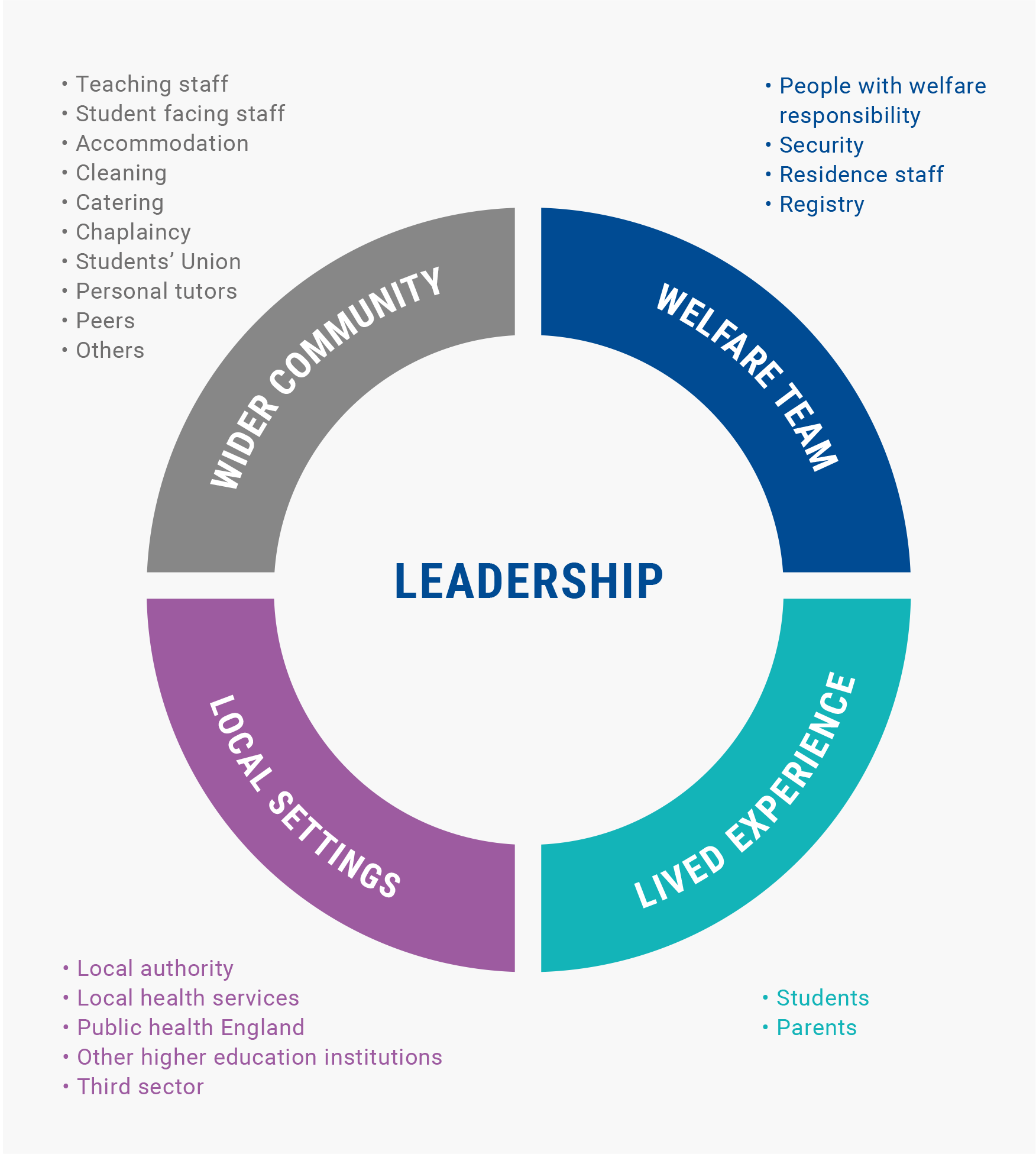Suicide prevention
Last updated: 22 November 2022
Content warning
This topic briefing discusses issues relating to suicide and mental health. It does not constitute regulatory guidance. It is intended to help providers develop suicide prevention strategies at their university or college. If you are affected by any of the issues raised, there are services that can help:
- The Samaritans are open every day of the year, you can phone them for free on 116 123 or email [email protected] (response time: 24 hours)
- SHOUT 85258 is a free, confidential, 24/7 text messaging support service for anyone who is struggling to cope
- Mind, the mental health charity, offers support by phone at 0300 123 3393 or online
- The NHS mental health information and support.
Effective practice advice
The following key areas are highlighted as important when providers consider how they might approach and develop suicide prevention strategies at their university or college.
With funding from the OfS, Universities UK (UUK) and Papyrus (the UK's national charity dedicated to the prevention of young suicide) published Suicide-Safer Universities guidance in 2018 to help university leaders prevent student suicides. The advice below is drawn from this guidance − further detail can be found within the guidance.
1. Take a whole provider approach
Understanding and addressing death by suicide in the student population, and embedding a suicide prevention plan, requires a strategic joined-up approach that involves the whole university or college community.
It is important to involve all parts of the institution, including students, staff, welfare teams, academic departments and student services (this includes staff from facilities including security, catering and domestic staff who are often key staff with whom students have regular daily contact), in making suicide prevention an institutional priority.

This image is taken from Suicide Safer Universities guidance, 2018
Ensure that members of staff, particularly in student-facing roles, are appropriately trained in suicide awareness and prevention and that this is kept up to date. Important areas to cover include how to spot the signs of distress, signposting and actions that should be taken.
Enable the appropriate sharing of information across departments and services within the university and triangulate data on student wellbeing. Establish internal systems to enable concerns and alerts to be raised, ensuring that students who are in distress or who are experiencing a mental health crisis and require support are identified and provided with appropriate intervention.
2. Ensure active and effective leadership
Ownership and accountability from senior leadership for suicide prevention work across the institution is key to engaging the whole university, and to getting commitment from across the university community to work together to improve policy and practice in this area.
Identify senior leaders who will take ownership of the suicide prevention strategy and take an active role in the institution’s suicide prevention team.
3. Work in partnership with the wider community
Working in collaboration with local authority suicide prevention partnerships, who specialise in mental health and suicide prevention work, and establishing links with voluntary organisations can support a whole community approach to sharing knowledge, expertise, insights and access to additional external resources and support.
Establish a clear care and support pathway for students flagged to be at risk working with student services, NHS partners and local authority mental health services and other appropriate external organisations.
Signpost students to where they can access help within the university community and to local services that can provide support and assistance to them.
4. Follow an evidence-based approach
Understand the student population and their needs by collecting and analysing appropriate data within the institution’s data policies.
Embed evaluation into all mental health and suicide prevention work so that activities and interventions are evaluated to understand what is working for which students and what could be improved.
Learn from other providers and other settings and sectors to identify suicide prevention policies and practices that might be effective. The OfS has collated further resources and effective practice case studies within this topic briefing.
5. Centre the needs of students
Make mental health for students a strategic priority by promoting awareness of mental health, signposting support available and encouraging people to be open and to talk about challenges that they might be experiencing.
Promote, support and encourage good mental health and wellbeing across the whole of the student experience and lifecycle, focusing in particular on transition points and groups of students who might be at greater risk of poor mental health.
Include and appropriately support students as co-producers when developing your suicide prevention plan.
Take steps to restrict access to locations that could be used for suicide attempts and to sources of information on suicide methods, where appropriate.
Establish a policy on information sharing with family and friends and ensure that disclosure and consent are considered appropriately and sensitively. UUK-Papyrus have published a guide for universities on sharing information with trusted contacts.
6. Develop postvention plans and support
It is important to consider in advance how to respond to a student death by suicide, who needs to be involved and what support is needed. A critical first response in universities and colleges is postvention support for friends, peers and staff affected by the death. It is important to be alert to a potential risk for suicide contagion or cluster, and therefore all communications and memorials relating to a student death by possible suicide should be handled sensitively.
It is also important to ensure a thorough ‘lessons learnt’ exercise is conducted and to review policies and procedures to make sure any changes that need to be made are captured. Wherever possible, ensure that bereaved families are involved in any postvention lessons learnt activities.
Last updated 06 October 2022 + show all updates
06 October 2022 - Link added to UUK-Papyrus' guide for universities on sharing information with trusted contacts.
18 May 2022 - Update on the anticipated publication date of the UUK consensus statement and guidance
Describe your experience of using this website
